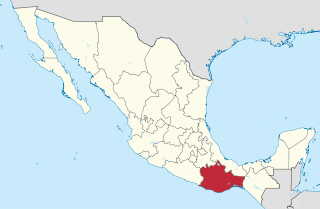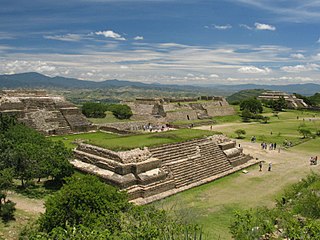Related Research Articles

Oaxaca, officially the Free and Sovereign State of Oaxaca, is one of the 32 states that compose the Federative Entities of Mexico. It is divided into 570 municipalities, of which 418 are governed by the system of usos y costumbres with recognized local forms of self-governance. Its capital city is Oaxaca de Juárez.

Oaxaca de Juárez, also Oaxaca City or simply Oaxaca, is the capital and largest city of the eponymous Mexican state of Oaxaca. It is the municipal seat for the surrounding Municipality of Oaxaca. It is in the Centro District in the Central Valleys region of the state, in the foothills of the Sierra Madre at the base of the Cerro del Fortín, extending to the banks of the Atoyac River. Heritage tourism makes up an important part of the city's economy, and it has numerous colonial-era structures as well as significant archeological sites and elements of the continuing native Zapotec and Mixtec cultures. The city, together with the nearby archeological site of Monte Albán, was designated in 1987 as a UNESCO World Heritage Site. It is the site of the month-long cultural festival called the "Guelaguetza", which features Oaxacan dance from the seven regions, music, and a beauty pageant for indigenous women.

The Oto-Manguean or Otomanguean languages are a large family comprising several subfamilies of indigenous languages of the Americas. All of the Oto-Manguean languages that are now spoken are indigenous to Mexico, but the Manguean branch of the family, which is now extinct, was spoken as far south as Nicaragua and Costa Rica. Oto-Manguean is widely viewed as a proven language family. However, this status has been recently challenged.

The Zapotec languages are a group of around 50 closely related indigenous Mesoamerican languages that constitute a main branch of the Oto-Manguean language family and which is spoken by the Zapotec people from the southwestern-central highlands of Mexico. A 2020 census reports nearly half a million speakers, with the majority inhabiting the state of Oaxaca. Zapotec-speaking communities are also found in the neighboring states of Puebla, Veracruz, and Guerrero. Labor migration has also brought a number of native Zapotec speakers to the United States, particularly in California and New Jersey. Most Zapotec-speaking communities are highly bilingual in Spanish.
Coatlán Zapotec is a Zapotec language spoken in southern Oaxaca, Mexico. It uses linguolabial sounds as onomatopoeia.

San Pedro Pochutla is a city and municipality located in the south of Oaxaca state, Mexico next to the Pacific Ocean. It is an important commercial, transportation and administrative hub for the Pochutla District in the east of the Costa Region. Pochutla is located at the junction of coastal Highway 200 and Highway 175 to Oaxaca, with 175 functioning as the town's main thoroughfare. Its name means "place of kapok trees ", and most of the city is built on a lakebed which was drained during the colonial period. The municipality is best known as being the home of the oceanside communities of Puerto Ángel and Zipolite.

The Zapotec civilization was an indigenous pre-Columbian civilization that flourished in the Valley of Oaxaca in Mesoamerica. Archaeological evidence shows that their culture originated at least 2,500 years ago. The Zapotec archaeological site at the ancient city of Monte Albán has monumental buildings, ball courts, magnificent tombs and grave goods, including finely worked gold jewelry. Monte Albán was one of the first major cities in Mesoamerica. It was the center of a Zapotec state that dominated much of the territory which today is known as the Mexican state of Oaxaca.
The 1999 Oaxaca earthquake occurred on September 30 at 11:31 local time in Oaxaca, Mexico, 60 km NNW of Puerto Ángel. The epicenter was located near San Agustin Loxicha. It had a magnitude of Mw 7.4. The maximum intensity reached MM VIII in southwestern Oaxaca, and could be felt strongly in Mexico City. The torrential rains preceding and following the temblor intensified the damage of this earthquake. Thirty-five people were reported dead. The archeological site of the ancient Zapotec city of Monte Alban also suffered damage in this earthquake. This was an intraplate earthquake in the Cocos Plate, with a normal-faulting mechanism. The fault plane was 90 km long and 45 km wide. The maximum slip was about 2.5 m, which was located about 20 and 40 km WNW of the hypocenter.
Mixtepec Zapotec is an Oto-Manguean language of Oaxaca, Mexico. It is reported to have 80% intelligibility with Lapaguía Zapotec, but with only 45% intelligibility in the other direction.
Zaniza Zapotec is an Oto-Manguean language of western Oaxaca, Mexico. It is one of several Zapotec languages called Papabuco. It has only 10% intelligibility with Texmelucan Zapotec, its closest important relative.
Texmelucan Zapotec is an Oto-Manguean language of the San Lorenzo Texmelucan Municipality in western Oaxaca, Mexico. It is a divergent Zapotec language, having only 10% intelligibility with its closest relative, Zaniza Zapotec. Both go by the name Papabuco.
Tlacolula Valley Zapotec or Valley Zapotec, known by its regional name Dizhsa, and formerly known by the varietal name Guelavia Zapotec is a Zapotec language of Oaxaca, Mexico.
Palantla Chinantec, also known as Chinanteco de San Pedro Tlatepuzco, is a major Chinantecan language of Mexico, spoken in San Juan Palantla and a couple dozen neighboring towns in northern Oaxaca. The variety of San Mateo Yetla, known as Valle Nacional Chinantec, has marginal mutual intelligibility.
Zoogocho Zapotec, or Diža'xon, is a Zapotec language of Oaxaca, Mexico.
Choápam Zapotec(Zapoteco de Choápam; in Veracruz Zapoteco de San Juan Comaltepec) is a Zapotec language of Oaxaca, Mexico.
Ixtlán Zapotec is a Zapotec dialect cluster of Oaxaca, Mexico.
Ozolotepec Zapotec is a Zapotec language spoken in southern Oaxaca, Mexico. It is partially intelligible with Cuixtla Zapotec and Loxicha Zapotec.
San Baltazar Loxicha Zapotec is a Zapotec language spoken in southern Oaxaca, Mexico. It is spoken in the towns of San Baltazar Loxicha and Santa Catarina Loxicha. It is not the same language as the other dialects spoken in towns named Loxicha, but it is in the same branch of Zapotec.
San Vicente Zapotec, is a Zapotec language spoken in southern Oaxaca, Mexico, in the Ejutla District and San Vicente Coatlán.
San Baltazar may refer to:
References
- ↑ Loxicha Zapotec at Ethnologue (18th ed., 2015) (subscription required)
- ↑ Salminen, Mikko (2014). Dí'ztè': o zapoteco de San Agustín Loxicha, Oaxaca, México. München: LINCOM.